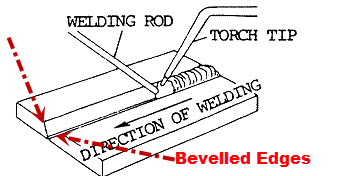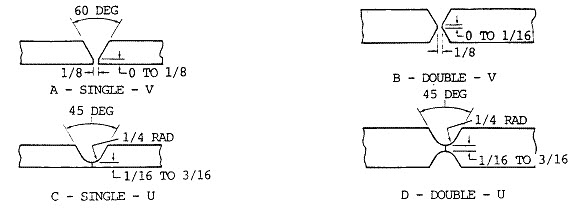How To Arc Weld Thick Metal:
To weld thick metal one eighth of an inch or greater you have to bevel the material first.
What is beveling? A beveled edge is where you basically take a square (90 degree) edge and grind it down to a more rounded or sloping edge.
A beveled edge makes it possible to weld thick metal plates together
because the beveled edges create an area for your filler metal to be
deposited and joining your pieces properly together.
There's different types of beveled edges depending on metal thickness and material but one of the common types of bevels you will perform is the simple V bevel. It looks like a V after you bevel two thick pieced of metal and then put them together to weld (seem image below).

Weld 3/16 Inch Metal Or More:
If you are welding steel plate that is more than 3/16 of an inch you should bevel the edges in order to get proper penetration, and therefore create a good weld at the joint. Some welders say 1/8 of inch or more.
You should also use the push welding technique when you weld thick metal 3/16 of an inch or greater.
Weld 1/2 Inch to 3/4 Inch Metal:
When welding steel plate that is anywhere from ½ inch to ¾ of an inch you should use the U type bevel to properly prepare your metal joint. It is similar to the V bevel but it's a U shape (see lower left corner of the image below).
You should consider using the backhand method of welding for welding 1/2 to 3/4 inch plate and with a U type groove.
By the way, it is not a good idea to use oxy-acetylene welding to weld thick metal that is .5 inches to .75 inches.

Weld 3/4 Inch Metal or More:
What are you doing welding something that is over 3/4 inch? You must be an advanced welder if you are doing that metal thickness (just kidding).
So if you are welding 3/4 inch metal or more you should use what is called a double V beveled edge or a double U beveled edge on your plates. These are also commonly referred to as V joints or U Joints, just so you know...
If you are going to be welding from one side of your metal then a single V or U joint is the way to go. And that is for metal of any thickness.
How To Get Better Control As You Weld Thick Metal:
As I inferred above, if you want to improve your speed and control of your welding of thicker metal, which is in the range of 1/8 inch or more, you should use the pull welding technique (otherwise known as backhand welding).
This has been studied and the result is that the pull welding technique (backhand) achieves good fusion at the root of the weld easier.
Tips For Welding Thick Metal:
- As you know from the previous information on welding the different thicknesses of metal, you should bevel your metal plates. Some say up to a 60 degree bevel depending on how thick the material is.
- You should consider tack welding your pieces and space the tack welds apart at different measured intervals.
- The main goal on thick metal is to achieve strong fusion and penetration at the base of your welded joint so you should use a welding rod that is fits well enough for this to happen. A 1/8 inch or 5/8 inch stick welding rod should be fine.
- After you create your first welding bead with the 1/8 inch or 5/8 inch rod, you should chip and clean it well. Then you will use a 5/32 or a 3/16 inch welding rod and filler to make more passes.
- Use a weave pattern if you are welding in the vertical, horizontal or flat welding positions. But if you are welding overhead you should consider string beading.
Trouble Welding Thick Plate?
If you are having trouble stick welding thick metal here is some advice:
- The first thing that's done when welding is to adjust the amperage to the thickness of the metal being welded. You go with a lower amperage for thin plate and a higher amperage for thicker material.
- If you get warping on your thick plate and your amperage was cranked right up then my advice to solve the warping problem would be to use the back-step welding procedure. This procedure distributes the heat more evenly. Any welding book or instructor would be able to share this.
- No matter how thick the metal is heat will distort. Clamping it down to a flat surface so it can not move then weld in sequence from one side to the other allowing it to pull against its self.
- Distortion is caused by excessive heat buildup. If you are building a structure then the structure usually prevents any distortion, but individual pieces that are not clamped or otherwise supported will distort with excessive heat.
- Even with clamping you will get some distortion from heat, so the solution is to weld in such a way as to prevent heat buildup.
- If possible, let the piece cool between weldments, and, if possible, move your welding locations about so the whole piece heats and not just one part of the piece.
- For more discussion on trouble weld thick metal try this.
Copyright WcWelding All Rights Reserved.
Welding Plans:
New! Welding Table
New! Log Splitter
Top Projects:






